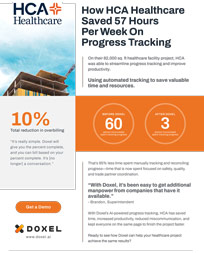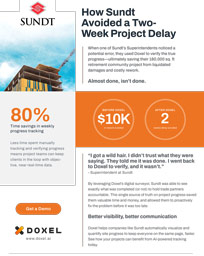How Automated Progress Tracking Helps Healthcare Construction Stay On Schedule
Healthcare construction is a specialized niche in the industry, and the projects within it require a high standard of attention to detail to meet their deadlines. These projects are complex and involve the coordination of large, cross-functional teams to complete them on tight schedules—which means a project’s success is majorly dependent on the efficiency and collaboration of the team building it.
Every day that the facility is delayed or past schedule means another day patients can’t come in, and the owner or company will lose money.
Enter, AI-powered project controls.
Staying on schedule and ahead of trends
The construction of healthcare projects is a delicate balance of innovation and realism. As one of the more technology-driven sectors, these facilities aim to have the latest and greatest equipment, but at the same time needs to be planned months in advance and available within a certain deadline. Teams must stay on top of an ever-changing landscape and varying demands—so having accurate, objective project progress data throughout is essential.
One of the biggest factors to staying on schedule is knowing exactly where you are. Without a single view of project progress, sticking to a set schedule becomes a risky guessing game. Progress tracking using the power of computer vision enables project teams to build faster and more accurately together.
After all, knowledge is power. Teams that leverage AI-powered performance monitoring are armed with accurate data in near real time to see backwards at what’s been done, as well as ahead at predictive insights.
Eliminating avoidable rework
Rework can be a project schedule’s worst nightmare—and the later it’s caught the bigger a scheduling headache you have on your hands. Rework takes valuable time away from what should be forward progress. In order to achieve schedule predictability, a project team has to be able to spot (and avoid) potential rework on the critical path.
Using computer vision progress tracking that acts as a digital surveyor, superintendents can quickly catch any missing or incorrectly installed components before the next trade covers up the error. This foresight can help avoid weeks of delays and schedule compression, which ultimately helps the facility stay on track to open on time or earlier.
Reducing downtime during maintenance
Real-time progress tracking doesn’t just help with new healthcare construction—it can also help reduce downtime during facility operations down the road.
Picture it (if you dare): A construction company closes off an area to cut into the wall and fix MEP services only to discover that it wasn’t installed per as-built plans. Instead of adhering to the plan, dreaded rework is now required.
But what if you had x-ray vision instead? Comprehensive reality capture of an as-built facility ensures maintenance teams know exactly what was installed and where, so any maintenance and retrofits can be done efficiently without the rework. Instead of costing days of downtime, teams can get in and get it done as planned the first time.
Using Doxel to increase construction efficiency
At its core, Doxel is automated progress tracking that provides objective, accurate data on materials installed for real-time project controls. The more teams can document in the moment, the more productive and proactive they become.
Find out how healthcare projects have used Doxel to deliver facilities earlier and at a higher standard of quality.







